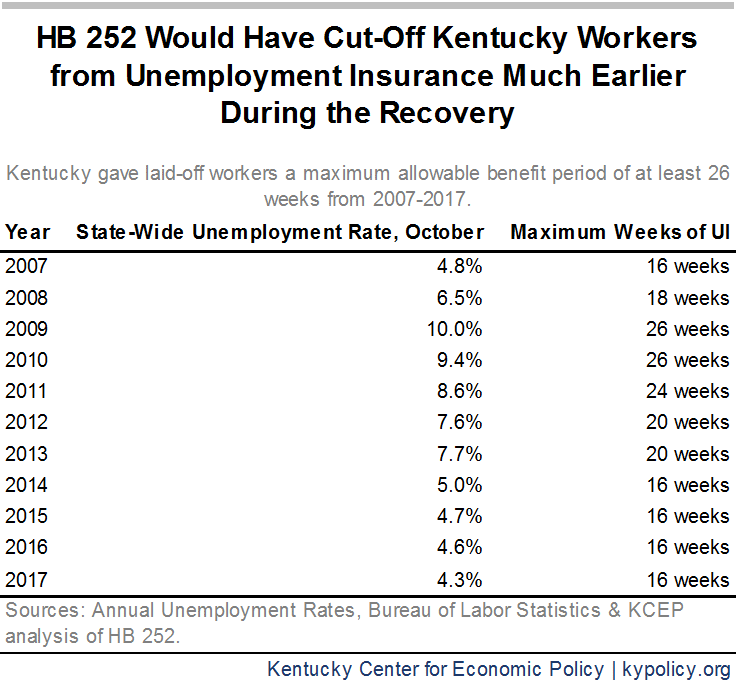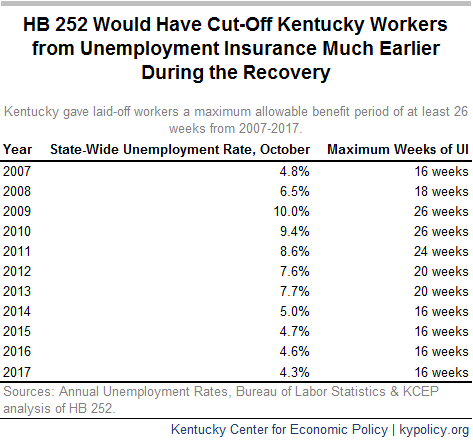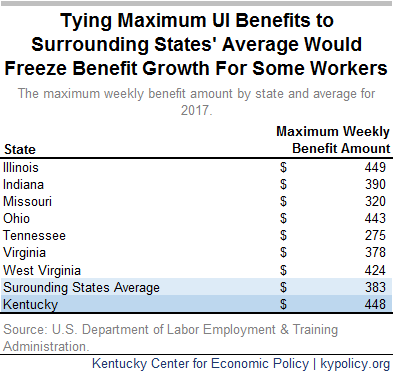Unemployment Insurance (UI) is a form of income-replacement coverage that keeps workers who lose their jobs out of poverty, boosts the economy in communities that experience downturns and helps to shorten recessions. Yet House Bill 252 would cut workers off UI much sooner, erode the maximum benefit compared to actual Kentucky wages and make fewer Kentucky workers eligible. It would worsen the harm to individuals and communities that fall on hard times.
Bill Cuts Off Benefits Early For All Kentuckians, Especially Harming Communities with Few Jobs and Workers of Color
Currently in Kentucky, if a worker is laid-off and qualifies for UI, he or she can receive benefits for up to 26 weeks – the standard which most states have provided historically. Under HB 252, the maximum allowable number of weeks benefits are provided would be reduced based on the state-wide unemployment rate to a range of 16 weeks if unemployment is below 5.9 percent to a maximum of 26 weeks if the unemployment rate is above 9 percent. The maximum allowable weeks would be reassessed in this way each April and October. If this provision were in place during the past ten years, far fewer Kentuckians could have received benefits even while the unemployment rate remained high in the weak recovery that followed the Great Recession:
On average, Kentuckians went back to work after 18.8 weeks of benefits in 2017, well before the deadline of 26 weeks. But workers who need the extra time to find a new job — whether because few jobs are available in their community or because they face barriers to employment ranging from a criminal record to lack of access to child care assistance or few educational credentials — benefit from the availability of additional weeks.
While these changes cut the weekly benefits window by up to 10 weeks for all Kentuckians, by using a state-wide unemployment rate as the gauge for the maximum allowable weeks, communities experiencing higher than average unemployment will be disproportionately harmed. Using October, 2014 as an example — the first period for which the minimum number of weeks would apply had HB 252 been the law during the recession and recovery – 42 rural counties, especially in eastern and western parts of the state, would have their maximum allowable weeks cut off even while their unemployment rates remained very high.
HB 252’s method of calculating the maximum allowable weeks of UI benefits would also exacerbate racial and ethnic disparities among Kentucky workers, failing to recognize discrimination in labor markets and other race-based barriers to employment. According to the 2016 American Community Survey:
- The unemployment rate for white Kentuckians was 5.4 percent, but for black Kentuckians it was 9.1 percent.
- The unemployment rate for non-Hispanic and Latino Kentuckians was 5.8 percent, but for Hispanic and Latino Kentuckians it was 6.6 percent.
Maximum UI Benefits Would No Longer Be Tied To Actual Kentucky Wages
UI benefits in Kentucky now only replace 38 percent of workers’ previous wages, an average of $322.48 per week and a maximum of $448 in 2017. But HB 252 would effectively erode benefits over time. It would freeze the maximum weekly benefit amount so that it doesn’t grow until the average of the seven surrounding states meets or exceeds Kentucky’s. Kentucky’s maximum weekly benefit is near the median, but above the current average as Tennessee’s maximum benefit is extremely low.
Some Low-Income Kentucky Workers with Irregular Incomes Would be Shut Out of Unemployment Insurance
The bill changes the way benefit eligibility is set in a way that would hurt low-wage workers in or on the verge of poverty. By increasing minimum qualifying wages, and moving the eligibility threshold from an annualized $3,000 to $6,000, workers earning less than $6,000 – who are often part-time and living paycheck to paycheck – would no longer qualify for UI. In doing so, this would magnify the harmful way Kentucky already sets monetary eligibility, which discriminates against people who have had income fluctuations in the past year – often due to part time work or changing jobs. In an economy increasingly made up of temporary agency jobs and part-time and gig work, this change would mean even fewer Kentuckians would get access to unemployment benefits. Already, only 19 percent of jobless workers in Kentucky receive unemployment benefits.
Unemployment Insurance is a lifeline for Kentuckians who face job loss. It also keeps the economy and local communities afloat during hard times; by one estimate, a dollar of UI benefits produced two dollars of economic activity during the Great Recession. Because of this, it is estimated that UI reduced the decline of economic activity during the recession by 18 percent. By replacing a fraction of workers’ wages, it blunts the vicious cycle of layoffs depressing demand, in turn leading to more layoffs. To limit the weeks these benefits are available, freeze the maximum benefit and reduce those who could qualify, Kentucky’s leaders would hamstring the state and communities’ ability to adequately respond to downturns in the future, and harm workers trying to make ends meet today.
Updated February 28, 2018.






